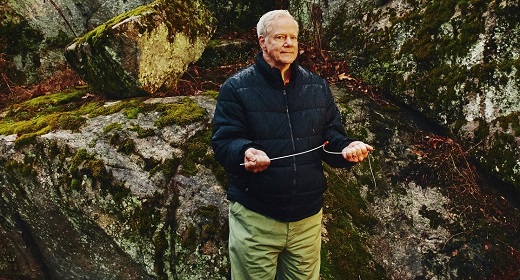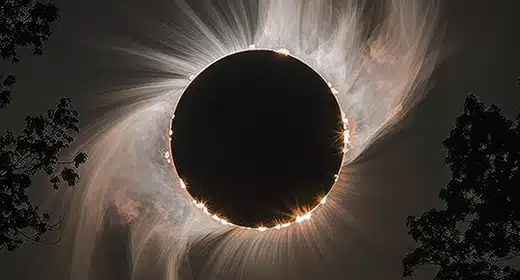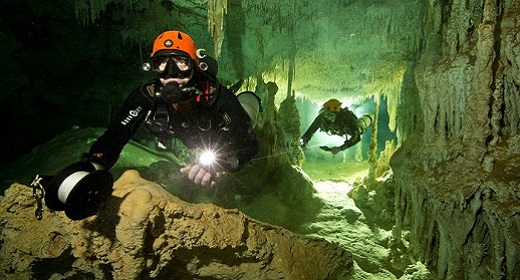by Dan Schwartz: For centuries, dowsers have claimed the ability to find groundwater, precious metals, and other quarry using divining rods and an uncanny intuition…
Is it the real deal or woo-woo? Dan Schwartz suspends disbelief to see for himself…
Leroy Bull was a boy who felt things other children did not. He sensed that there was something right on the edge of his reality, in rural Bellefonte, Pennsylvania, where he grew up in the 1940s and ’50s. Sometimes it sent him messages, although at the time he did not know them as such. What he knew was that in school his eye was drawn out the window and into the woods, where his world hushed.
He quickly learned not to tell the other kids that sometimes, in these moments, he thought he glimpsed the future. Once, when he was older, he called his high school sweetheart and urged her to stay home from school. She hung up, ignored his advice, and broke her ankle that afternoon in gym. As a child, kids called Bull crazy. Was he? He didn’t know. He was surer of himself when he was alone.
There was an old strip mine up the road from his home, and he liked to walk there. The floor of the mine was unnaturally flat and its walls steeply sloped, but he would pick his way down a few times a week, enter that vast space, and feel small. There, he was most aware of the hush. It was like the bottom of a deep breath. It was as if he had grown wings and flown out of this world. Going down was always like returning.
People are most aware of the other side when they’re young, before they grow up and come to distrust what they can’t measure, he says now. Yet some adults retain the feeling, and they may pass along what they’ve learned to those who are open. Bull’s grandfather lived on a farm on the edge of Watertown, New York. He felt something, too.
Bull spent his summers on that farm in upstate New York punching cows, as he puts it, six days out of seven. One spring, on Easter Sunday, when Bull was 12 and he and his brother and the cousins were all up in the front yard, his grandfather disappeared into the woods. When he emerged, he was clutching half a dozen branches he’d cut from the willows. They were shaped like wishbones.
He handed the branches around and showed the kids how to hold them—palms skyward, points facing forward like the needle on a compass. Then he lined the children up before what he said was an underground vein of water that fed a black pitcher pump, and the old-timer told them to walk.
Well, the kids walked, and when they walked over the ground said to have water beneath it, a few of their rods, as it happened, dipped.
Bull’s was the first. His brother’s didn’t budge.
Afterward, their grandfather pulled Bull aside and said, “If you can learn to use that in your lifetime, do it, because it will probably help you.”
Bull would not realize for some time that what he had done that Easter Sunday was to channel the other side—the spirit world, as he calls it—which always felt strongest when he was close to Mother Nature, when the din of his world hushed and the messages from the other side rose in him like goose bumps. He would not learn until his twenties that he could call upon the hush to find things—water, minerals, utility lines—on a map; he would be in his forties before he learned to summon from the silence images of missing people or lost pets or misplaced wedding rings; and not until he was a half-century old would he realize, with shock, that on rare days he could project visions onto the landscape to guide him in his search, like the time a golden grid of shimmering lines snapped above the grass and led him to a well site. Bull’s calling, he would learn, was in finding things the old way, with his intuition as a guide and a forked stick as a pointer, like dowsers have for centuries. All his powers would come in time. It was on that Easter Sunday, when Bull was just a boy, that he took the first step: he learned to find water.

Even today, finding water underground can be a gamble. You may search the landscape for clues, for a valley, say, or a cottonwood stand. You may unfurl a geologic map, scanning for underground pockets where water pools. You may study your neighbors’ wells to surmise the depth of the one you will drill. Or you may hire a geologist to do all that for you. But none of it guarantees that a rig won’t just turn dirt, and missing is expensive. In New England, for instance, every foot bored can cost $15, and the average well depth is 280-odd feet. Ultimately, there’s no way to know for sure what’s underground until you dig. Most guess and hope for the best.
But some look elsewhere. Dowsing is the old-world way of finding things. It is not, definitively, a science; it is pre-science—a method born before the Enlightenment to find, among other things, water, minerals, oil, gemstones, buried treasure, energies emanating from the earth, fugitives, missing kids, missing dogs, missing cats, and, according to some fervent practitioners, the pears that are ripest in the produce aisle. Its names are as numerous as its aims: divining, doodlebugging, water witching, water smelling, peach-twig toting, well prophesying, rhabdomancy, and, from the lips of the most pragmatic among them, finding water with a stick. Dowsers locate their targets based on the movements of handheld rods, which can be anything from branches to bastard files to horsewhips. They also use pendulums: a penny on a wire, or keys suspended from a Bible, or quicksilver in a bottle on a string. The power is not in the device, for it merely channels, dowsers say; the power is out there, and an attuned hand and quieted mind can discern it.
Detractors say it’s all hooey. Science has shown that hidden desires can move your muscles subconsciously, and this is why the rods point and the pendulums swing. (This “ideomotor effect” also explains Ouija boards.) Successes are exceptions. Dowsers are charlatans who more often fail to find what they seek, or find it by dumb luck.
Many of those who hire a dowser say they don’t know how the magic works, only that it does. “It’s just—insane,” says Steven Strong, a homeowner in Vermont’s Upper Valley. “I’m an engineer. I know physics. I can’t explain any of it.” But when the well on his property stopped producing about five years ago, the man Strong contracted to drill a new one had no idea where to put it. (Drillers don’t locate the water; they only strike it.) At the driller’s recommendation, Strong hired a dowser, a man from up north named Steve Herbert.
He watched Herbert circle his property for some time. Then, about 50 feet from the dried-up well, the dowser hammered a stake into the earth. He proclaimed that, if placed right here, perfectly vertically, the rig would hit a spring that gushed 25 gallons per minute of good, clean water. The driller drilled. Water rushed. “Honest to goodness, without any embellishment,” Strong said, “it was exactly spot-on. Not 23.5. Not 26. But 25 gallons a minute. I was there and I didn’t believe it, and the well driller was slack-jawed.”
“I’ll tell ya,” that driller, George Spear, said, “whatever it is, if someone ever unlocks the mystery, it’ll be amazing, because some people have it.”
Drilling companies rarely recommend dowsers to their clients, but the practice is common nonetheless. Associations have formed around the world to study dowsing and teach its power. There are, among many others, the British Society of Dowsers, the Irish Society of Diviners, the Dowsers Society of New South Wales, the Canadian Society of Dowsers, the Japanese Society of Dowsing, the Asociación Argentina de Radiestesia, and the Ceska Psychoenergeticka Spolecnost, in the Czech Republic.
The American Society of Dowsers, headquartered in Danville, Vermont, has some 2,000 members. They hail from every state in the union. Most live west of the Mississippi. Very few—not even 50 in the U.S., a veteran dowser told me—have been at it for decades like Leroy Bull has. Most are hobbyists, Bull says.
Bull was once the president of the American Society of Dowsers and is considered a sage in his field. One source I spoke to called Bull the best dowser in America. Bull says he has found more than 1,500 well sites in three countries. He may have a knack for water, but he’s received calls from seekers of many other things. Car keys. Cash. Wills. A long-lost galleon. Also: missing people, which can be dark work. About a week after 9/11, he says, an FBI agent called to ask whether anyone was still alive in the fallen towers. They’re all dead, Bull reported. Last September, he says, he was called to help find a paraglider who had disappeared somewhere in the Nevada desert. Later that month, a driver found the paraglider; he was dead. Neither the FBI nor the Nevada Division of Emergency Management would confirm Bull’s involvement in these investigations, but the federal government has, on occasion, consulted clairvoyants, according to case files. Even today, so late in his career, Bull receives about three requests each month. He charges $300 to $400 a day, plus expenses.
n a September morning in Stamford, Connecticut, I go to see Bull. He is working on a job for a man in Hueco, Texas. Bull is 77 now but distinctly boyish. He chuckles frequently and delights in small things, like the chipmunks on the other side of the glass doors of the pool house where we’re sitting. They keep darting by. Bull, neatly dressed in a salmon-colored button-front shirt and brown slacks, is at the far end of the table looking at a map of the man’s property. Even before the pandemic, Bull had shifted to doing most of the work remotely, because he’d long since learned to solve these problems from the comfort of his home.
The Texan asked Bull to find three things: locations for an orchard, a well, and a vegetable garden. In Bull’s right hand, he is dangling a silver chain over the map, and at the end of the chain is the tip of a buckhorn, which he is rocking forward, backward, forward, backward.
“Question number one,” Bull says, “Can I? May I? Is this an appropriate time?”
The pendulum begins to spin clockwise. It is his answer.
“Yes,” he says.
Now he may begin. He settles into a hush like he did down on the mine floor some three-quarters of a century ago, and his mind is as placid as a dark, windless lake. Then he casts a stone in. Where on this property, he asks, can the landowner grow a successful orchard?
In his left hand is a pen, and as he drags it along the bottom edge of the map, the pendulum in his right hand rocks again: forward, backward, forward, backward.
Bull is calling on his spirit guides: Running Deer, a translucent ruminant Bull only ever sees in the woods, an agent of nature; Lisa, a woman, likewise diaphanous, who is his agent of emotions; and Zenoff, a Russian man who appears to Bull as a real, in-the-flesh human. He, a medium once told Bull, is an agent of the angel of death. A dowser is a conduit for knowledge from the spirit world, and these guides help Bull direct the information he seeks into this world. They speak to him in a tongue he feels in the back of his mind, which confused him as a child. But with training he has learned to decipher the messages, and right now they’re telling him to spin his wrist.
The pendulum spins clockwise. He stops his pen.
He marks the spot on the bottom of the map where the pen stopped with a little circle. Axis number one.

Bull repeats the process on the long edge of the map and finds his second axis. All he needs now is his T square to find the intersection of the two axes, and an X will mark the spot where he believes the landowner can grow a successful orchard. But he’ll do that later. Now the well.
“Is there a place I could mark for him to get enough water for years to come?”
The pendulum, which is rocking again, swings.
“And the answer is yes.”
He works the edges of the map as before. The pendulum rocks. The pen slides. The pendulum swings. The pen stops. The site, he discovers, is on the rim of the forest.
“OK, so there is his well,” he says, “close to the house.”
But there is still more to learn. Bull raises the pendulum again and it starts rocking. How many gallons a minute could the well produce?
“Ten? Twenty? Thirty? Forty?”
The pendulum swings on 40.
He repeats the process to find the approximate depth of the well, which, he discovers, is 250 feet.
Just for fun, and seemingly for my benefit, Bull also asks if there are any natural resources in large enough quantity to be economically feasible to take from the ground.
This time the pendulum swings counterclockwise.
“No. OK,” he says. “So he won’t make money digging for pirate’s gold.”


Rods such as the kind Bull learned to use when he first found water as a child have long been conduits of magical power in the popular imagination. In Homer’s Odyssey, Circe, the daughter of the sun god Helios, turned humans who reached her isle into wild beasts who served her. Homer said she used a wand and refers to it in Greek as rhabdos, meaning “rod.” The Roman statesman Cicero called this a virgula divina, or “divine rod.” Around the early 16th century, in the hands of the Germans, it became a divining rod: wünschelrute.
The Germans discovered dowsing amid a mining bonanza, as a method for detecting mineral ore beneath the earth’s surface. But even in the Middle Ages, dowsing chafed advocates of scientific methods of prospecting. It also affronted the Church, which proclaimed it the devil’s work. Georgius Agricola, a scholar and scientist known as the father of German mining, said that those wielding the rod were either wizards—whose power came from unholy incantations “it would not become me to repeat”—or rubes. He observed that many guided by the rod dug frivolous pits. “Therefore a miner, since we think he ought to be a good and serious man, should not make use of an enchanted twig,” Agricola wrote in 1556, “because if he is prudent and skilled in the natural signs, he understands that a forked stick is of no use to him.”
But German prospectors continued traipsing the hills, guided by the rod. Some found the branches of the hazel tree best suited to divining veins of silver. For other metals they sought other species. Ash for copper. Pitch pine for lead and especially tin. Several years after Agricola blasted the enchanted twig, the English kingdom asked for help developing its nascent mining industry. It needed brass to forge cannons for its naval fleet. Germany sent an expert, who packed a dowsing rod. Dowsing soon spread through every country in Europe. It rolled right into the 18th-century Enlightenment.
This was the so-called Age of Reason. Things, henceforth, needed explaining, and savants struggled to account for dowsing. But even as the Enlightenment popularized scientific reasoning, some old-world methods endured. As they sailed to foreign lands and displaced, killed, or subjugated their peoples, Europeans packed their rods. Bull’s family came from Scotland and England.
Istruggle with what to make of this magic. When I was a child, I was convinced that there existed, down the street from the house I grew up in, a portal to another land. I could see it in my mind, behind a tall white fence of a sort so common in suburban Rhode Island: a swath of lush grass, perfectly cut, and along one edge, ringed by hay bales, a circular, shimmering gateway.
I had long sensed something supernatural there but hadn’t given it a shape or a name. Then my friend called it a doorway. She lied a lot, and even at the age of seven I was leery of her claims, but her suggestion was like watercolor exploding across my mind. It was the birth of an idea, and what came with it was the obsession that I could step through that portal.
Every time my mom drove past the house, I’d scan the fence for gaps between the slats. I daydreamed of sneaking out on a cloudless night, scaling the fence, dropping into whoever’s yard it was, and army-crawling across the lawn to the ring of hay bales. Then, in the moonlight, gaping at the portal. But I grew up without ever attempting it.
A quarter-century later I can still feel the portal’s pull. It’s like a broken promise. Some adults like to tell children that when they grow up they’ll lose their imagination, but these adults are merely spiteful because they long ago abandoned theirs. I never lost mine. What I lost was an open mind, and I want it back.
At the table in the pool house in Connecticut, after he has finished with the map of the property in Texas, I tell Bull about the portal. It’s afternoon now, and we’re eating pizza. I had long attributed the image of the portal to a muscular imagination, but during our conversations, Bull’s account of his visions sounded similar. What did he make of my portal?
He pulls the pendulum from his shirt pocket and begins rocking it above the table. It quickly circles clockwise.
“You were right,” he says. Then, without pause, he tells me all about such portals.
Imagine, he says, a clothesline. A bedsheet hangs over it, and the wind is blowing one side into the other. Where they touch, you see sunlight.
“Wormholes. Punctures in time. Overlaps,” he says. They’re everywhere. Sometimes they’re in the sky; other times they’re in the bushes. Sometimes they’re closed; other times they’re open. And when they’re open, well, you can pass through them. Not to the spirit world. No, they’re only manifestations of this realm. But to other times.
“If you carry your .357 and you go back in time, you’re the boss. If you go forward in time, it ain’t shit,” he says, smiling, because: “ray guns.”
He knew a guy who walked through a few portals in New Mexico and Arizona. He always went back in time, and he always carried.
“What?” I ask.
“A pistol. That’s all I know.”
But he’s dead now, Bull says. He died on this side.
“When I dowse a property and they have kids and the portal’s down close to the ground, I ask them if they want me to zip it closed. And yeah,” he says, “I can do that.”
The long table between us suddenly feels short. I look at him, speechless.
“Yeah.” He takes a bite of pizza. “There are wormholes.”
As I search for words, Bull produces his pendulum and asks whether there’s a portal on the property on the map before him. It spins counterclockwise: no. No buried treasure. No interdimensional buccaneering. If I were the landowner, I’d be disappointed.
Ispend that night on the southern edge of Connecticut in a scummy two-star hotel, turning my conception of reality over and over in my head. So much of Bull’s childhood sounded like mine. He was a loner. He was sensitive. He felt at peace in the woods. Most of all, his family nurtured his knack for dowsing. I was 12 when we stopped making nighttime offerings of candies to the fairies. And yet there’s such a distance between the boy I was and the man I am now. To the boy, this world was once one of beautiful mysteries, a world more felt than known.
And what is science but magic explained? Like my younger self, dowsers aren’t concerned with knowing the contours of reality. They are preoccupied with feeling them. Many dowsers believe that water snakes up from the earth in narrow veins. Striking it, therefore, would be a feat. But geology tells us that water is distributed in sheets under the earth, in pores and cracks and pockets in subsurface rock. We call this groundwater. In many regions, it’s everywhere beneath the surface of the earth. Still, the question remains: How deep down is it located?

Perhaps the most conclusive scientific evidence against the efficacy of dowsing was a government-funded, randomized study in Germany in the late 1980s, which in fact had initially served as evidence for it. The study was conducted in a two-story barn. On the first floor was a long pipe with water flowing through it. The pipe was fixed to a wagon, which the researchers rolled to various arbitrarily chosen spots below. Then they brought dowsers up to the second floor and asked them to locate the water. Over a two-year period, they tested 43 of the most promising dowsers, winnowed from a field of 500 originally recruited for the study.
After crunching the numbers, the lead researcher, a physicist, concluded that although most of the dowsers did poorly, six of them displayed “an extraordinarily high rate of success, which can scarcely if at all be explained as due to chance.” Therefore, he stated, “a real core of dowser-phenomena can be regarded as empirically proven.” So there it was: proof.
Except that it wasn’t. In the mid-1990s, a University of California at San Diego professor scrutinized the German physicist’s statistical analysis and determined that it was “special, unconventional and customized.” Analyzed correctly, he wrote, the results were consistent with statistical fluctuations, meaning: there is no dowsing effect. “In fact,” he wrote, “it is difficult to imagine a set of experimental results that would represent a more persuasive disproof of the ability of dowsers to do what they claim.” So there you had it: disproof.
Bull believes what he says. I did my journalistic diligence and searched for any lawsuits accusing him of fraud. I found none. I talked with other dowsers who know him, and they all respect him. And Bull connected me with one client (although I asked him for more), Mark Godshall, in Telford, Pennsylvania, who told me, “I don’t have a clue how he does it. But I guarantee you, he’s the real thing. He finds water like nobody else.” Godshall says that people from around the country call him, asking for “that dowsing guy.”
Still, the authority on this country’s landscape and its natural resources, the U.S. Geological Survey, knows of no evidence that dowsing can be used to detect water beneath the ground. There’s no official body that tracks dowsers’ work. “Other than the fact that I’m talking to you and I get paid by the government,” Bill Cunningham, a USGS senior groundwater scientist, tells me, “we don’t spend any of the public’s resources on proving something that has many times failed to be proven scientifically.” Although Cunningham never says dowsing is bunk, his tone is clear enough.
But what does he make of the success stories?
“I don’t have a science or engineering explanation for it, which leaves only the other types of explanations.”
Such as?
“Uh. Non-science-and-engineering explanations,” he says, and laughs.


Afew days later, I meet another dowser at a property in Barnet, Vermont, in the remote region known as the Northeast Kingdom, where the land feels regal and old. On hillsides in the distance, maples and birches and beeches and elms blaze with shades of crimson and gold. In a field alongside the property’s driveway, wild grass nods in the wind. If Bull can square both worlds, why can’t I?
The dowser, 68-year-old Steve Herbert, who had done Steve Strong’s property in Vermont, agreed to show me his technique. His conception of the other side is more folkloric than Bull’s. Its beings are agents of Mother Earth who facilitate the workings of our natural world. They are the gnomes that live beneath the soil in rocks and ores and roots, the undines that float through water and flit through mist, the fire spirits that bask in heat and light, the sylphs that seek dry air. There are others, but these are the ones he calls upon most, for they, like any good custodian, know where to find this world’s things.
Herbert, who is wearing an olive button-front shirt tucked into blue jeans, stands in the gravel driveway gazing into the field. He dowsed a series of well sites on this property when he worked it a week ago, and he brought me back to retrace his steps. On his right hip is a leather holster. In it are two L-shaped rods that he bent from brass brazing wire. In a holster on his left hip is a bundle of metal stakes called survey arrows. But he always turns to the clipboard in his hands first.
Before dowsing for a well, Herbert determines four parameters: location, depth, yield, and quality. On this property, the location is the field, he says; anywhere else would be too close to the septic system or impossible for a 25-ton drill rig to reach. The depth is no greater than 300 feet, where water is commonly found in Vermont, and no less than 50, because anything shallower risks fecal contamination from the cattle the landowners may raise. The yield, according to his rule of thumb, is five gallons per minute, unless his clients need more, and here they don’t. Finally, the quality, he says, must exceed 3.5, which on his one-to-ten scale is at the edge of potable. Ten is perfect.
Herbert writes all this down on his clipboard. So much of dowsing is asking the right questions, he says, and with these parameters defined, asking is simple. He will inquire of the elemental beings: Is there any well site in the area that meets all these criteria? Herbert typically uses an aura meter, an elaborate pendulum that resembles a chrome heron with a spring-loaded neck that bobbles in different directions to answer questions. “It’s the Cadillac of dowsing tools,” he says. The other day, when he asked the aura meter whether the water was at 300 feet, the answer was no. So on his clipboard he adjusted the maximum depth to 350 feet and asked again. This time: yes.
With the parameters confirmed, he’ll read them to the landowners to, as he puts it, program the information in their minds—and his. That way they’re sending the same message to the nature spirits as he searches for the right spot.
“So now,” he says in the driveway, “it’s time to break out the L rods.”
In the old days, a dowser might zigzag all over a field until the L rods tugged, Herbert says, “but modern dowsers have a shortcut method.”
He draws a single L rod from his hip and, gripping it like a revolver in his right hand, pans it slowly across the job site. He is scanning, which seems like a sensible thing to do. And then suddenly I’m witnessing something I’ve never seen.

Herbert’s arm continues panning, but the L rod rotates in his hand, as if the tip has locked onto an invisible magnet. He wiggles his hand back and forth for emphasis: Stuck, see? It. Is. Un. Canny. I look for some sleight of hand but can’t detect any movement in his wrist.
We walk into the wild grass on the bearing Herbert dowsed, and I feel my reality slipping.
There’s a wooden stake at the first site, placed there the other day, with a little surveyor’s tape tied around the top. We’re standing a dozen or so feet back from the stake. Herbert draws both L rods from his hip and holds them like a pair of revolvers.
People have different reactions, he says. In some hands the rods swing closed. In others they swing open. For Herbert they swing open. “You can feel the tug,” he says, walking toward the stake now.
What tug?
Then, as he steps over the stake, the rods swing outward.
Yeah, Bull had said, there are wormholes.
A hush settles over me.
“What does the tug feel like?” I ask. “Is it like, uh, magnetism?”
“You know what?” he says. “I could give you a chance to feel the tug yourself.”
We are now walking to the second site he marked. The first site was good, he says. He had dowsed 14 gallons a minute with a quality of 8.4 at a depth of 315 feet, which exceeded his requirements. But the second site is better.
Herbert says he records four parameters, but really he has five, and I think about the fifth as we walk. Above all, he told me, he must not transgress Mother Earth or her spirits. They must approve his work, and he must respect, appreciate, and acknowledge them. But our materialistic culture makes it easy to ignore the damage we cause Mother Earth.
At the second stake, Herbert hands me his L rods and walks away to pee in the bushes. The rods are heavier than I expected, and cold against my skin. I hold them as Herbert instructed—elbows by my sides and fists out, like a gunslinger—and silence my mind as best I can. He pointed just downhill of the stake and said water ran there, why don’t I go to it. So I do, one step at a time.
The rods begin to close. The metal sticks in my palms and pops free and the rods continue to close. They close like strong hands have grabbed them and are twisting them in. They close like rain must fall and wind must blow, like it’s their natural course, like they always have and always will.
And now they are closed. I look at them in my hands: they are perfectly parallel. For a moment, I feel like something is looking back at me—into me. It feels like love. Then, as Herbert returns from the bushes, it passes.
“Yeah,” he says, reading my expression, “there’s nothing like that—turning by themselves in your hands—to make you pay attention.”






















































